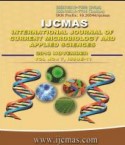


 National Academy of Agricultural Sciences (NAAS)
National Academy of Agricultural Sciences (NAAS)

|
PRINT ISSN : 2319-7692
Online ISSN : 2319-7706 Issues : 12 per year Publisher : Excellent Publishers Email : editorijcmas@gmail.com / submit@ijcmas.com Editor-in-chief: Dr.M.Prakash Index Copernicus ICV 2018: 95.39 NAAS RATING 2020: 5.38 |
Rich genetic potential with wide spectrum of genetic variability is a key factor behind a successful breeding programme. New recombinants can be generated through crossing between highly diverse parents. Genetically diverse 281 RILs and their parents were grown in randomized block design in two replications under rainfed and irrigated conditions during rabi 2011-12 and 2012-13. Categorization of RILs was done by using standard statistical procedure based on qualitative and quantitative traits. RILs were evaluated for traits name. Transgressive variations and their new combinations with other traits had been identified for presence of stem pigmentation, pink flower colour, dark green leaves, erect growth habit, brown seed colour and rough seed surface in RILs those are similar to kabuli type and no-pigmentation in stem, white flower and light colour leaves recorded similar to desi type RILs. Pea-shaped (microsperma type) RILs identified with white flower, non-pigmented stem, large leaves, variation in seed colour and surface. New variations were observed in qualitative traits as well as new recombination of various traits in angular, owl’s head and pea-shaped groups of RILs. The best RILs identified for different traits include RILs 31 and 33 (early flowering), RIL 77 (late flowering), RILs 33 and 12 (early maturity), RILs 120 and 109 (reproductive phase duration, biological yield, harvest index and plant canopy), and RILs 41 and 109 (seed yield) under both irrigated and rainfed conditions. The identified RILs with desirable trait combinations can be utilised in chickpea breeding programme for seeking improvement in yield and its component traits.
 |
 |
 |
 |
 |